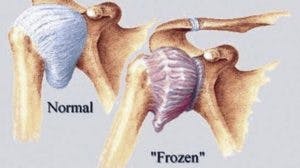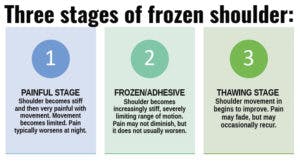A frozen shoulder occurs when your shoulder joint and surrounding ligaments stiffen up. Your surrounding muscles also become affected. In most cases, this happens without any specific injury. Sometimes only a minor trivial incident, like bumping your shoulder against a wall, can be the trigger.
The underlying pathology of a frozen shoulder is not well understood. Some reports show the inner lining of the shoulder becomes inflamed. Other studies show a lack of inflammation. Changes in blood flow and nerve sensitivity have also been found. However, it is well known that the outer capsule of the joint shrinks and thickens leading to significant pain and loss of motion.

Who Gets a Frozen Shoulder?
Frozen shoulder affects 2% to 5% of the population. The disorder most commonly affects women between the ages of 40 and 65. It often occurs in both arms several years apart. It is also more common in those with certain diseases, such as diabetes and thyroid disorders.
Signs and Symptoms
Patients with a frozen shoulder often experience pain at rest, which is worsened at night and with movement. As the disorder progresses, range of motion becomes increasingly restricted. Pain typically begins to subside during this time, but function can remain extremely limited due to stiffness. The inability to reach overhead and behind the back are hallmark signs.
What to Expect with a Frozen Shoulder
Frozen shoulder progresses through stages throughout 1 to 3 years. The first stage, called the “Freezing Stage” is characterized primarily by increasing pain with some loss of motion. As the disorder progresses into the “Frozen Stage”, pain begins to subside but significant stiffness is present. During the “Thawing Stage”, pain diminishes and range of motion slowly improves.
Previously, it was believed that a frozen shoulder would resolve on its own by waiting 12 to 18 months. However, several studies show persistent loss of motion and limited function for up to 3 years. Therefore, it is important to take an active approach to avoid a delayed recovery. Three of the most common treatment options include physical therapy, corticosteroid injection, and manipulation under anesthesia.
Physical Therapy for a Frozen Shoulder
Stretching exercises can be an effective treatment option for people with frozen shoulders. However, the exercise program must match the stage of the disorder. Overly aggressive stretching performed in the “freezing stage” can result in increased pain and delayed recovery. Your physical therapist carefully prescribes exercise to meet your goals.
Manual physical therapy can also be an effective treatment for people with frozen shoulders. In particular, joint mobilization and passive stretching techniques are useful in the later stages when pain is minimal. The effects of manual therapy are always enhanced when patients perform regular home exercises.
Injections for a Frozen Shoulder
Injections can be particularly helpful during the early “freezing stages” of a frozen shoulder. They help reduce some of the acute pain that occurs at night and while at rest. Research shows combining injections with 4 to 6 weeks of daily home stretching can significantly improve pain and function. Caution should be used for those with diabetes. Steroid injections acutely influence blood sugar levels. You can discuss this with your doctor to determine the best course of action.

Manipulation under Anesthesia
When stiffness is slow to resolve, your physician will consider a manipulation under anesthesia. There may be some short-term increase in pain for several days. However, when combined with regular home exercise and supervised physical therapy, manipulation under anesthesia can be very effective for improving function.

Get Help for Your Frozen Shoulder
A frozen shoulder can be very frustrating because of the prolonged recovery. However, there are effective treatments that can reduce your pain and frustration. Some treatments even speed up your recovery.
If you are suffering from a frozen shoulder, discuss these treatment options with your physician or physical therapist. The doctors of physical therapy at BSR have been helping people move without pain since 2007. Call our office to schedule an appointment with your physical therapist.



